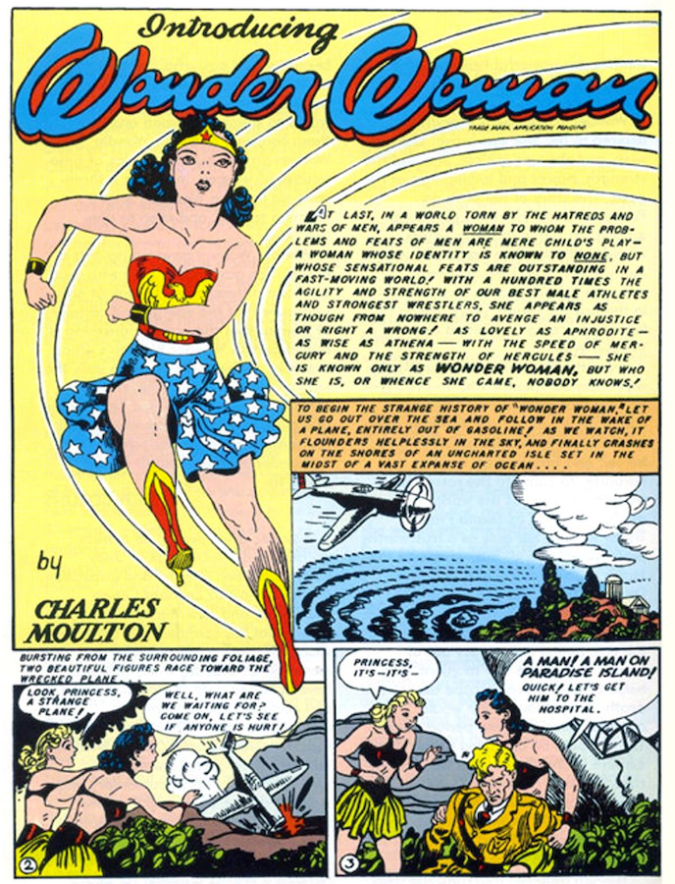Let’s play a game. It’s called ‘Name a Superhero’. Anyone will do, just think of one.
Okay… Go. Got one?
Chances are it’s got a ‘man’ suffix, right? Spiderman, Superman, Batman – in the arena of superheroes there’s no doubt that it’s a (Super)man’s world.
But what about the women, asks filmmaker Kristy Guevara Flanagan in Wonder Women: The Untold Story of American Superheroines (2012). Specifically, what about Wonder Woman, feminist icon and one of the longest-running comic characters of all time?
With the long-promised Wonder Woman movie almost upon us, what better time to dive into the original Nazi-puncher’s origin story…

Flanagan’s film charts the evolution and impact of Wonder Woman, while exploring the empowerment of women over the past eight decades.
Wonder Woman was created by psychologist and inventor William Moulton Marston (inventor of the systolic blood pressure test, a central component of today’s lie detector), a man with no writing credentials who fast-talked his way into a comic writing position after pitching the idea of a female superhero, describing his creation as “psychological propaganda for the new type of woman who should, I believe, rule the world”.
When Wonder Woman (Diana, an Amazonian warrior princess) burst onto the pages of DC comics in 1941, it was right in the middle of WW2. All over America, women had left their kitchens and stepped into the workforce in order to keep the wheels of industry turning while all the able-bodied men were off giving Hitler and the Axis what for. By 1945 more than 2.2 million women were working in the war industries, along with countless non-war-based industries.
From flying planes to playing baseball, in the early 1940s much of the essential and non-essential work was carried out by US women and the wheels of industry continued to turn, without the world spinning off its axis (pun intended). It was in this new world of female dynamism that the Wonder Woman comics at first flourished.
When the war ended the men returned home and resumed their former careers, while the women who had been driving the engine of industry returned to the kitchen sink. Gradually a collective sense of amnesia set in, until the important role of played by woman in wartime was all but forgotten.
This was reflected in the pages of Wonder Woman, and from the late 1940s until the ’60s, Princess Diana’s stories became increasingly lacklustre. (This was not helped by the advent of the Comics Code Authority (CCA), a self-regulatory body formed in the 1950s as a response to public concern over the link between “objectionable” comic book content and juvenile delinquency.) A post-war sexism had set in, and by the ‘60s the once proud female scourge of countless villains and Nazis could be found power-less (having surrendered her powers in order to remain in ‘Man’s World’) and running a clothing boutique.
At this point in time, the Woman’s liberation movement was gaining momentum. Feminists like Gloria Steinham, angry at the lack of female heroes and incensed at Wonder Woman’s enfeebled state, insisted that the character be returned to her former glory as “a symbol of female power”. Terrified at the prospect of further attacks by Steinham and co, DC comics capitulated and even threw in a black female sidekick called Nubia. Score two for equality!
Next in the evolution of Wonder Woman was her incarnation on the ‘new media’ of the 1970s – television. The live action Wonder Woman (played by the beautiful Lynda Carter) was genuinely groundbreaking – to have a female lead on a TV show in the ’70s was unheard of (and sadly remains a difficult sell for network execs to this day), and it opened the door for a host of female-led shows like The Bionic Woman and Charlie’s Angels.

The most compelling message of Wonder Woman, the television series was clear and impactful: woman can be, and often are, heroic too. This live-action portrayal of a powerful, intelligent and fearsome female warrior provided inspiration to a generation of girls growing up in the 1970s. In Flanagan’s film, the testimonial given by Linda Carter about grown up Wonder Woman fans telling her how much the show inspired them to succeed as woman in male-dominated professions – as astronauts, NASA scientists etc – is heartwarming.
Still, amid all the empowering talk one depressing fact surfaces. Buffy and Wonder Woman, Ripley, Captain Janeway and Agent Dana Scully are all female heroines created by men.
Why are there so few female-created superheroines? One answer could lie in good old-fashioned gender imbalance; since the vast majority (97%, according to the recent statistics from Women’s Media Centre in America) of decision-making media positions are held by men, the roles and input of woman are limited.
Women still live in a world bombarded with over-sexualised versions of femininity, a world where they still earn less than their male counterparts and have less decision-making power over how they are portrayed in the media. And in this depressing context, Flanagan’s film is essential viewing.